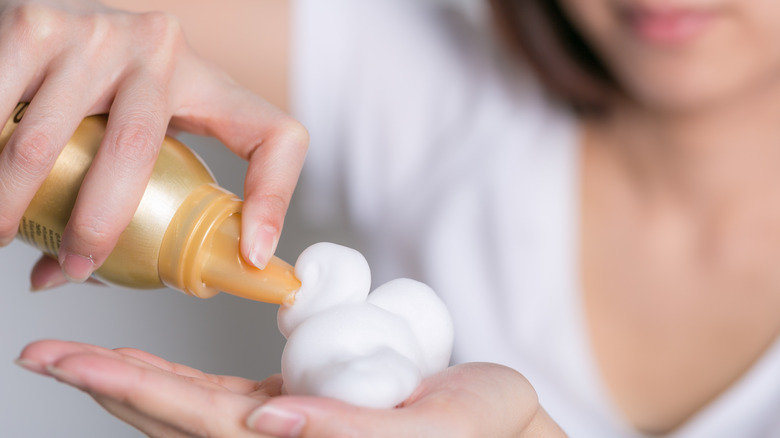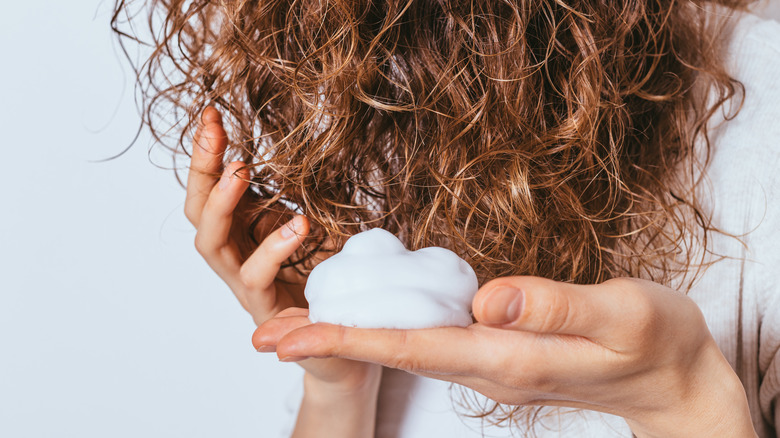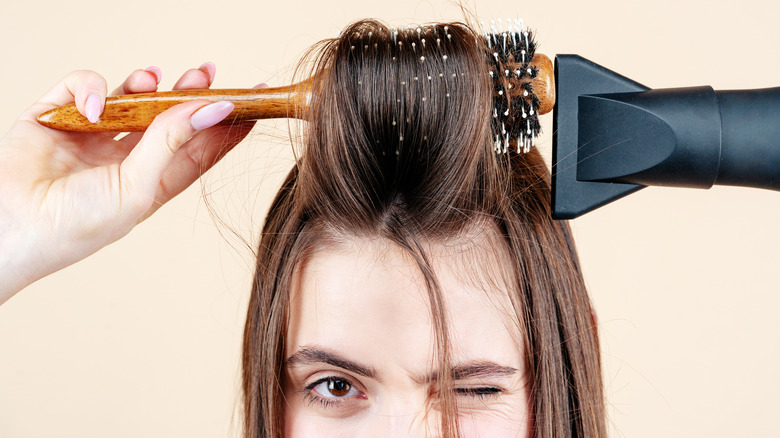Here's How To Use Hair Mousse For Any Type Of Hair
Sometimes, the only polite thing to do when you're in a group of laughing people is to laugh right along with them. You know — like when you somehow find yourself in front of a 1980s television show or movie and your friends begin to rip on the characters, especially the women. "Look at that hair!" "Could it get any bigger?" "If it did, it could be a parachute that could lift her off the ground!"
They'll laugh until they're doubled over, and you'll laugh, too, though no one notices that it's not the guttural laugh you're known for. No one knows what you're really thinking: So, how did they achieve that look? In fact, a few tools may have converged to create that primped, plumped, and puffed-up look, and one of them was most likely hair mousse. The 1980s weren't called the "mousse mania" era for nothing (via Maple Holistics).
On one hand, the look may be as dated as shoulder pads. (Everything was big in the '80s.) But for every person who asserts that "mousse is back," there are probably two people who say, "Who are you kidding? Mousse has been here the whole time."
Learning how to take a page out of the "big hair" decade isn't difficult, but a few pointers should assist your best efforts, no matter how big of a statement you want your hair to make — or what type of hair you happen to have.
Make a little magic with mousse
It's amusing to look back on it, but many people didn't know what to make of mousse when L'Oréal unveiled it in the early 1980s (via Hairstyle Camp). Packaged in an aerosol container, it needed a good shake before it released a whipped, foamy substance. Then, as now, filling the palm of your hand with an egg-sized amount of foam is a good place to start your mousse journey. You'll find that mousse can add body, bounce, and volume to hair and give it staying power, without the obvious stiffness of hairspray.
Like hairspray, mousse comes in different formulas. For example, they might be targeted at people who want extra hold or flawless curls. But generally, mousse works best when it's applied to damp hair after it's been shampooed, the Jean Louis David salon says. Furthermore, Pattern Beauty recommends wringing out your hair before squeezing the foam into your palm until the foam fully expands. Grab some mousse with your other hand and then work the mousse through your hair with your fingers, starting with your roots to create volume.
If you want to show off your natural waves or curls, let your hair air dry, L'Oréal recommends. If you want volume (or that big hair look), dry your hair with a blow dryer or a diffuser. Flip your hair over and dry it to create volume. Then, use a round brush and lift hair up from the roots to add height.
Personalize your mousse routine
Now, you're entering the realm of preference. And like every other part of your daily beauty routine, using the iconic styling foam requires some experimentation to find the methods that work best for you, not the masses.
For example, after applying mousse to wet hair, you may always want to apply it to wet hair, especially if you're concerned about keeping any stiffness to an absolute minimum. But keep in mind that you can apply the foam to dry hair if you need a quick touch-up, the Jean Louis David salon says. Just be sure to keep the foam ball in your palm to a minimum. Or, if you just can't break your fondness for having damp hair first, wet your hair in the appropriate spot and then apply the mousse. Similarly, for every person or company, like L'Oréal, that advocates that "less is more" with mousse, there may be those who suggest being "super generous with it" (via Who What Wear).
It makes sense to start with less mousse and then make that foam ball bigger if your hair is long or if you decide you want more hold from the mousse. Who What Wear and others also prefer spreading mousse with a wide-tooth comb for more uniform coverage. It's worth a try, especially if you want to embrace the '80s and release your inner Julia Roberts or Jon Bon Jovi.


